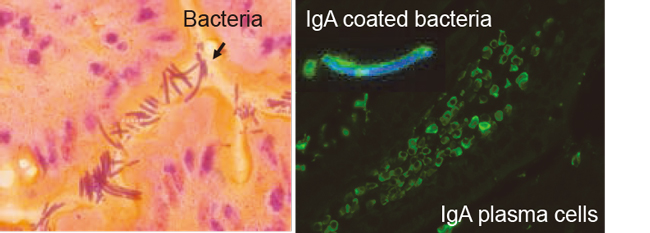Laboratory for Mucosal Immunity
Current research
Our previous studies demonstrated that the absence of immunoglobulin A (IgA), the major effector molecule of the adaptive immunity in the gut, or the impaired IgA selection in germinal centers (GC) due to deregulated T cell control, severely affects the balance of gut bacterial communities, resulting in massive activation of the immune system in the entire body. The absence of a subset of Foxp3+ T cells induced by bacterial antigens also modifies the composition of the gut microbiota by evoking mucosal TH2 inflammation. Interestingly, the Foxp3+ T cells induce GC and IgA responses by generating GC T cells (TFH and TFR cells), and their depletion causes a rapid loss of specific IgA responses in the intestine. Together, all these observations pointed to the existence of a Foxp3-IgA axis in maintaining the gut microbiota balance. It remained unclear however, how these specific arms of the adaptive immune system mediate host-microbial interactions in the gut. We found that Foxp3+ T cells contribute to diversification of the gut microbiota, particularly of species belonging to Firmicutes. The control of indigenous bacteria by Foxp3+ T cells involved their regulatory functions outside and inside of the GCs, suppression of inflammation and regulation of IgA selection in Peyer’s patches, respectively. The diversified and selected IgA repertoires generated in the presence of Foxp3+ T cells in the GCs (TFR cells) associate with specific coating of a large diversity of bacterial species and their maintenance rather than exclusion from the gut. By contrast, the IgAs generated in the absence of TFR cells associate with abundant coating of bacteria with largely non-specific IgAs, reduced diversity and skewed gut microbiota. Thus, the adaptive immune system, through its cellular and molecular components required for immune tolerance, and diversification as well as selection of the antibody repertoire, mediate host-microbial symbiosis by controlling the richness and balance of bacterial communities required for homeostasis.

A section of Peyer's patch Gram stained (left panel) showing mostly Gram positive segmented bacteria trapped in the mucus layer (yellow). Under normal conditions, a large fraction of the commensal bacteria are coated with IgAs produced by the plasma cells in the lamina propria (shown in the right panel).
